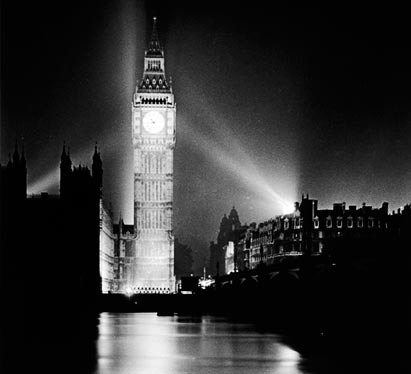A Legacy of Horological Excellence
Watch, Chronometer and Clock Makers - Since 1814
Introduction | Chronometers | Standard Clocks | Royalty & Domestic Clocks and Watches | Turret Clock - Public Clocks - Big Ben | Patents | 20th Century | 21st Century | A Brief Summary of Works, Patents and Medals | Sources
IntroductionThe history of Dent & Co. spans three centuries of precision watch and clock making in Great Britain. Established in 1814 by Edward J. Dent, the company embraced the Victorian fervour for technological innovation and created precision chronometers to navigate the Royal Navy and guide some of the most intrepid explorers on their voyages. The British Empire was in full expansion and its maritime tradition had produced some remarkable technological breakthroughs from the late 18th century; John Harrison’s triumphant mechanical solution in 1764 to locate a ship’s position at sea won the coveted Board of Longitudes prize money and further consolidated Britain as the horological force in the world. Propelling the impetus of Britain’s primacy, Dent proved a key player in Victorian horological history manufacturing the Standard Clock at the Royal Observatory, Greenwich which was to keep “Greenwich Mean Time” the time to which all others in the Empire were referred, (better known today as G.M.T.) and continued to do so until replaced by an electronic clock in 1946. Dent also made probably the most famous clock in the world - the Great Clock for the Houses of Parliament, familiarly known as Big Ben. |
Royalty & Domestic Clocks and WatchesDent’s flair for exquisitely wrought domestic clocks and watches afforded the company a Royal Warrant as the official watch and clockmaker to Her Majesty Queen Victoria and HRH Albert Prince of Wales in 1841, a warrant that would be renewed through to George V’s reign. Russian emperors Tsar Alexander III and Tsar Nicolas II and the Japanese Emperor Mejii also issued Dent with royal warrants. |
A Brief Summary of Works, Patents and Medals of Dent & Co.
1790
1800
1814
1815-29
1829
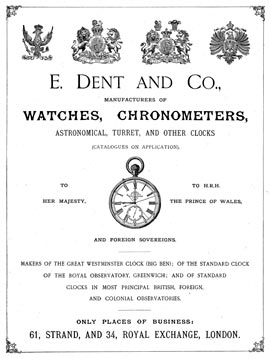
1830
1831
1833
1834
1836
1837
1838
1839
1840
1842
1843
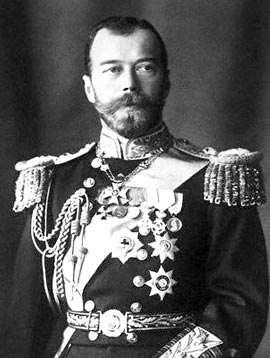
|
1845
1846
1847
1848
1849
1850
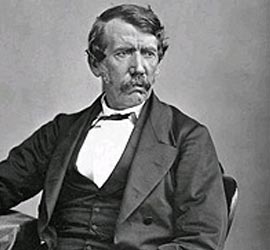
1851
1852
1853
1854
1855
1856
1857
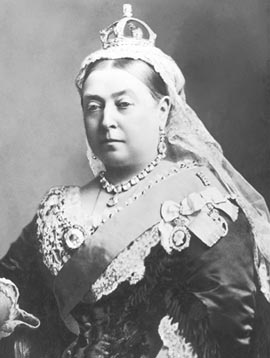
1859
1862
1863
1865
1867
| 1868
1869
1870
1871

1872
1875
1876
1877
1878
1879
1880
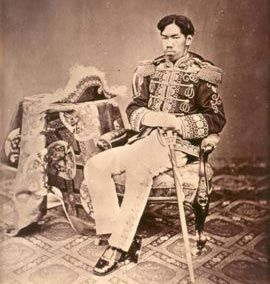
1890
1901
1904
1908
1901 – 1930
1949 -1963
1950 – 2006
2006
2008
|
Company Names & titles
Over the centuries, the company changed its name a number of times, retaining continuity with the presence of “Dent” throughout. To achieve this, one generation would be distinguished from another because the full name would include the initials of the family member who inherited part or all of the relevant business.
With approximate dates, the company’s names included:
1826-30 |
E.J. Dent |
1830-40 |
Arnold & Dent |
1840-53 |
Edward J. Dent |
1853-61 |
Frederick Dent |
1853 – 1920 |
Richard Edward Dent, and M.F. Dent (absorbed into E. Dent & Co Ltd in 1920) |
1861-64 |
Dent & Co |
1864-97 |
E. Dent & Co |
1897- today |
E. Dent & Co. Ltd |
A Chronology of Business Premises – all premises are in London, England
1826 |
E.J.Dent, 43 King Street, Long Acre |
1830 |
Arnold & Dent, 84 Strand |
1840 |
Edward J. Dent, 82 Strand |
1843 |
Edward J. Dent, 82 Strand & 33 Cockspur Street |
1847 |
Edward J. Dent, 82 Strand & 33 Cockspur Street & 34 Royal Exchange |
1851 |
Edward J. Dent, 61 Strand & 33 Cockspur Street & 34 Royal Exchange |
1853 |
Frederick Dent, 61 Strand & 34 Royal Exchange |
1853 |
Richard Edward Dent, 33 Cockspur Street |
1856 |
Frederick Dent, 61 Strand, 34 & 35 Royal Exchange |
1857 |
M. F. Dent, 33 Cockspur Street |
1861 |
Dent & Co, 61 Strand, 34 & 35 Royal Exchange |
1861 |
M. F. Dent, 33 & 34 Cockspur Street |
1864 |
E. Dent & Co, 61 Strand, 34 & 35 Royal Exchange |
1886 |
E. Dent & Co, 61 Strand, & 4 Royal Exchange |
1897 |
E. Dent & Co Ltd, 61 Strand, & 4 Royal Exchange |
1904 |
M. F. Dent, 34 Cockspur Street |
1920 |
E. Dent & Co Ltd (consolidation M. F. Dent), 61 Strand, 4 Royal Exchange & 34 Cockspur Street |
1921 |
E. Dent & Co Ltd, 61 Strand, 4 Royal Exchange & 28 Cockspur Street |
1936 |
E. Dent & Co Ltd, 41 Pall Mall & 4 Royal Exchange |
1941 - 1977 |
E. Dent & Co Ltd, 41 Pall Mall |
Dent & Co. also acquired a range of titles and appointments. They include:
Makers to and holders of Royal Warrants from Her Majesty Queen Victoria and H.R.H. Albert, Prince of Wales, His Majesty King Edward VI, His Majesty King George V, Her Majesty Queen Mary, His Majesty Tsar Alexander III, His Majesty Tsar Nicolas II Emperors of Russia and His Majesty Emperor Mejii of Japan. Makers to the Courts and Governments of France, Austria, Italy, Russia, Germany, Spain, the United States, Japan and others.
Sources;
Guildhall Library, “Edward John Dent & His Successors” by Vaudrey Mercer, Patent Office Library, British Library.

